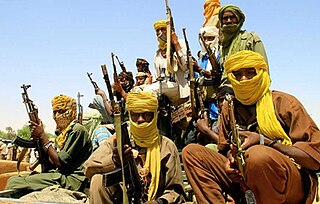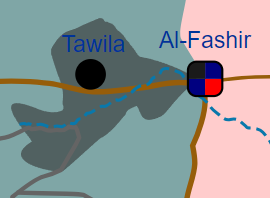
Khartoum or Khartum is the capital city of Sudan. With a population of 6,344,348, Khartoum's metropolitan area is the largest in Sudan.

Sudan, officially the Republic of the Sudan, is a country in Northeast Africa. It borders the Central African Republic to the southwest, Chad to the west, Libya to the northwest, Egypt to the north, the Red Sea to the east, Eritrea and Ethiopia to the southeast, and South Sudan to the south. Sudan has a population of 50 million people as of 2024 and occupies 1,886,068 square kilometres, making it Africa's third-largest country by area and the third-largest by area in the Arab League. It was the largest country by area in Africa and the Arab League until the secession of South Sudan in 2011; since then both titles have been held by Algeria. Sudan's capital and most populous city is Khartoum.

Tuti Island is an island in Sudan where the White Nile and Blue Nile merge to form the main Nile. It is surrounded by the "Three Towns": Khartoum, Omdurman, and Khartoum North. Despite this, Tuti is home to only one small village, with grassland being the main makeup of the island. In the past the only approach to Tuti Island was via several ferries that cross the river intermittently, but the Tuti Bridge, a modern suspension bridge, was completed in 2008 and can be used instead. The island area is 3.99 square kilometres (1.54 sq mi).
Sir John Watson Gibson was an English civil engineer. He designed dams in England and in Anglo-Egyptian Sudan and port installations in England and Ireland. In the UK he is most notable for having designed a key part of the Mulberry harbours for the 1944 Normandy landings.

Pauling & Co. was a major British civil engineering contractor renowned chiefly for building the railways of Southern Africa.

The Sudan People's Liberation Movement–North, or SPLM–N, is a political party and militant organisation in the Republic of the Sudan, based in the states of Blue Nile and South Kordofan. The group's armed forces are formally known as the Sudan People's Liberation Army–North or SPLA–N. In 2011 when South Sudan broke away from Sudan to form a new country, most of the Sudan People's Liberation Movement (SPLM) and Army (SPLA) left with it, leaving units remaining across the border in Sudan to form the SPLA–N.

The Sudanese conflict in South Kordofan and Blue Nile was an armed conflict in the Sudanese states of South Kordofan and Blue Nile between the Sudanese Armed Forces (SAF) and the Sudan People's Liberation Movement–North (SPLM-N), a northern affiliate of the Sudan People's Liberation Movement (SPLM) in South Sudan. After some years of relative calm following the 2005 agreement which ended the second Sudanese civil war between the Sudanese government and SPLM rebels, fighting broke out again in the lead-up to South Sudan independence on 9 July 2011, starting in South Kordofan on 5 June and spreading to the neighboring Blue Nile state in September. SPLM-N, splitting from newly independent SPLM, took up arms against the inclusion of the two southern states in Sudan with no popular consultation and against the lack of democratic elections. The conflict is intertwined with the War in Darfur, since in November 2011 SPLM-N established a loose alliance with Darfuri rebels, called Sudan Revolutionary Front (SRF).

The Rapid Support Forces is a paramilitary force formerly operated by the government of Sudan. The RSF grew out of, and is primarily composed of, the Janjaweed militias which previously fought on behalf of the Sudanese government. Its actions in Darfur were deemed crimes against humanity by Human Rights Watch.
The following lists events during 2023 in the Republic of the Sudan.

A civil war between two major rival factions of the military government of Sudan, the Sudanese Armed Forces (SAF) under Abdel Fattah al-Burhan and the paramilitary Rapid Support Forces (RSF) and its allies under the Janjaweed leader Hemedti, began during Ramadan on 15 April 2023. Three minor (neutral) factions have also participated in the fighting: the Darfur Joint Protection Force; the SLM (al-Nur) under Abdul Wahid al-Nur; and the SPLM-N under Abdelaziz al-Hilu. Fighting has been concentrated around the capital city of Khartoum and the Darfur region. As of 14 November 2024, at least 61,000 people had been killed in Khartoum State alone, of which 26,000 were a direct result of the violence. As of 5 July 2024, over 7.7 million were internally displaced and more than 2.1 million others had fled the country as refugees, and many civilians in Darfur have been reported dead as part of the Masalit massacres.

The battle of Khartoum is an ongoing major battle for control of Khartoum, the capital city of Sudan, with fighting in and around the city between the paramilitary Rapid Support Forces (RSF), and the Sudanese Armed Forces. The battle began on 15 April 2023, after the RSF captured Khartoum International Airport, several military bases, and the presidential palace, starting an escalating series of clashes.
The following is a timeline of the Sudanese civil war (2023–present) in 2023.

The siege of El Fasher is an ongoing battle for control of the town of El Fasher in North Darfur during the Sudan conflict. The first battle for the city took place between 15 and 20 April 2023, and resulted in a ceasefire that held until 12 May. Clashes broke out again between 12 and 29 May, and ended with a more stable ceasefire that lasted until August. By September, the city had become a haven for refugees across the region, without enough food and water.
The following lists events during 2024 in the Republic of the Sudan.
The Battle of Wad Madani was a battle in the Sudanese civil war over the control of Wad Madani, the capital of Gezira State in east-central Sudan, between the Sudanese Armed Forces (SAF) and the Rapid Support Forces (RSF). The battle ended in an RSF victory on 19 December 2023.
The siege of Babanusa was a siege during the Sudanese civil war. The siege started when fighting erupted between the Rapid Support Forces (RSF) and the Sudanese Armed Forces (SAF) on 22 January 2024 near Babanusa.
The following is a timeline of the Sudanese civil war (2023–present) in 2024.
The paramilitary Rapid Support Forces (RSF) has waged a major offensive against the Sudanese Armed Forces (SAF) in Sennar State, resulting in widespread violence and displacement, as part of the ongoing Sudanese civil war.
A series of air strikes are being conducted by the Sudanese Armed Forces (SAF) against positions of the Rapid Support Forces (RSF) across Sudan, resulting in a significant increase in the number of civilian deaths in the war. Civilian areas and RSF-held positions have been targeted by the SAF in North Darfur, North Kordofan, Gezira State, and White Nile State, resulting in an estimated death toll of 523 Sudanese civilians.
The battle of Dinder was a series of battles in the town of Dinder during the RSF's offensive in Sennar State.










